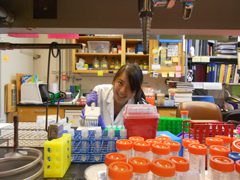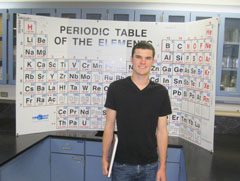Henry Sweat

Currently, many structural engineers do not take masonry (or more technically infill walls) into account when they design a structure. In other words, they assume that the masonry that goes in between the structure has no effect on the building. The problem with this approach is during an earthquake, the bricks can affect the fundamental manner in which the structure reacts because, contrary to the design philosophy, they carry load and increase the stiffness of the building. My research is based on using a computer simulation called OpenSees to discover […]
Michael Appel
Caenorhabditis elegans is a widely studied bacterivorous nematode that is typically grown on one specific strain of E. coli as its standard food source for experiments. However, in nature the worm encounters almost endless varieties of bacterial food sources and establishes a much different microbiota than those grown in our sterile lab environments. Our lab is attempting to characterize this yet unknown normal mircobiota of C. elegans and to understand how different bacteria may provide benefits for the worm. So far our lab has identified two soil isolates that seem […]
S. Zayd Enam

Using the tools of machine learning one can determine parameters of a model that probabilistically best fit experimentally collected data. This gives us insight into determining the model that best describes the data. I will be using machine learning to fit models of receptive fields of auditory neurons (a receptive field is any stimulus that maximizes activation of a neuron) that have been generated using a sparse-coding model. In this case, a sparse-coding model is one that minimizes the number of neurons required to represent different sounds. Sparse-coding models have […]
Flora Ting

Determined Biochemical Benefits of Gene Therapy on the Peripheral Nervous System Smith-Lemli-Opitz Syndrome (SLOS) is a hereditary disorder characterized by physical dysmorphia, mental retardation, and delayed growth. The principal cause of the disorder is a defect in the gene that codes for the enzyme 7-dehydrocholesterol reductase (DHCR7), resulting in cholesterol deficiency as well as the toxic accumulation of its precursor, 7-dehydrocholesterol (7DHC). The gene for this missing enzyme will be delivered via a viral vector to treat mouse models genetically engineered to mimic SLOS in humans. Since cholesterol is critical […]
Viktoria Betin
My project will study a bacterial-eukaryotic signaling interaction. Through the secretion of chemical signals, bacteria affect animal health and morphology. As the closest living unicellular relatives of animals, choanoflagellates are a good model system for the study of the evolutionary origins of long-standing partnerships between animals and bacteria. Choanoflagellates are single-celled eukaryotes that form colonies under certain conditions. A sulfonolipid molecule (a structural relative of the common cell signaling moleculessphingolipids) produced by the bacteria Algoriphagus machipongonensis triggers multicellular development in the colonial choanoflagellate Salpingoeca rosetta. This bacterial-eukaryotic biochemical signaling interaction […]
Helen Tran

To infect host cells, Salmonella uses its Type III Secretion System to inject virulence factors necessary for pathogenesis. Understanding the movement of ATP in Salmonella will help us understand how this bacterial pathogen regulates its secretion of virulence factors and its communication with host cells. This summer, I am performing a genetic analysis on bacterial proteins involved in ATP secretion of Salmonella. After screening a panel of E. coli mutants for defects in ATP secretion, it was concluded that mutants were defective in ATP secretion when two subunits of an […]
Jason Yoon
Through immune surveillance, the immune system can identify cells as self or non-self i.e. transplanted, cancerous, or pathogen-infected. Immune surveillance relies on antigen presentation to T cells. Some of these antigens arise from endogenous protein translation, through either conventional methods of translation or certain cryptic means of translation. Previous work done in the Shastri lab has shown that antigens may be generated through the usage of an alternate-non-AUG initiation codon and that this mechanism is distinct from the conventional AUG-mediated translation. This work has been done using one particular antigen-reporter […]
Bryce Jarman

The goal of my research project is to study a new method of bioconjugation: an oxidant mediated coupling reaction. This reaction is highly site specific and unreactive with the functional groups traditionally found in biological systems, making it useful for the efficient construction of biomaterials with a variety of different functions. Although this reaction has already seen a variety of uses, further studies into the mechanism will allow for even greater tuning of the reactions selectivity and efficiency. To do this I will prepare a set of internal standards and […]
Jordan Tsai

I am studying the degradation of plant biomass in the fungal model organism Neurospora crassa. The study of plant biomass degradation is important because it will both help us understand the molecular mechanisms behind this essential ecological process, and may also aid in the production of biofuels derived from lignocellulosic biomass, which could serve as an alternative to petroleum based fuels. Previous genetic analysis has implicated a N. crassa serine-threonine kinase in the cellulolytic metabolism pathway, but its molecular mechanisms remain unknown. I want to investigate the role of this […]
Rodger Yuan
Batteries with high energy density have important applications as energy storage devices in portable electronics. This summer, I will be studying solid-state lithium-sulfur batteries with block copolymer electrolytes. This the benefit of this design is twofold: the Li-S chemistry has a theoretical specific capacity over 6 times that of todays lithium-ion battery and the polymer electrolyte eliminates the need to use liquid organic electrolytes, which are flammable and volatile. However, there are many challenges that must be overcome before Li-S batteries are viable as future energy storage systems. The problem […]